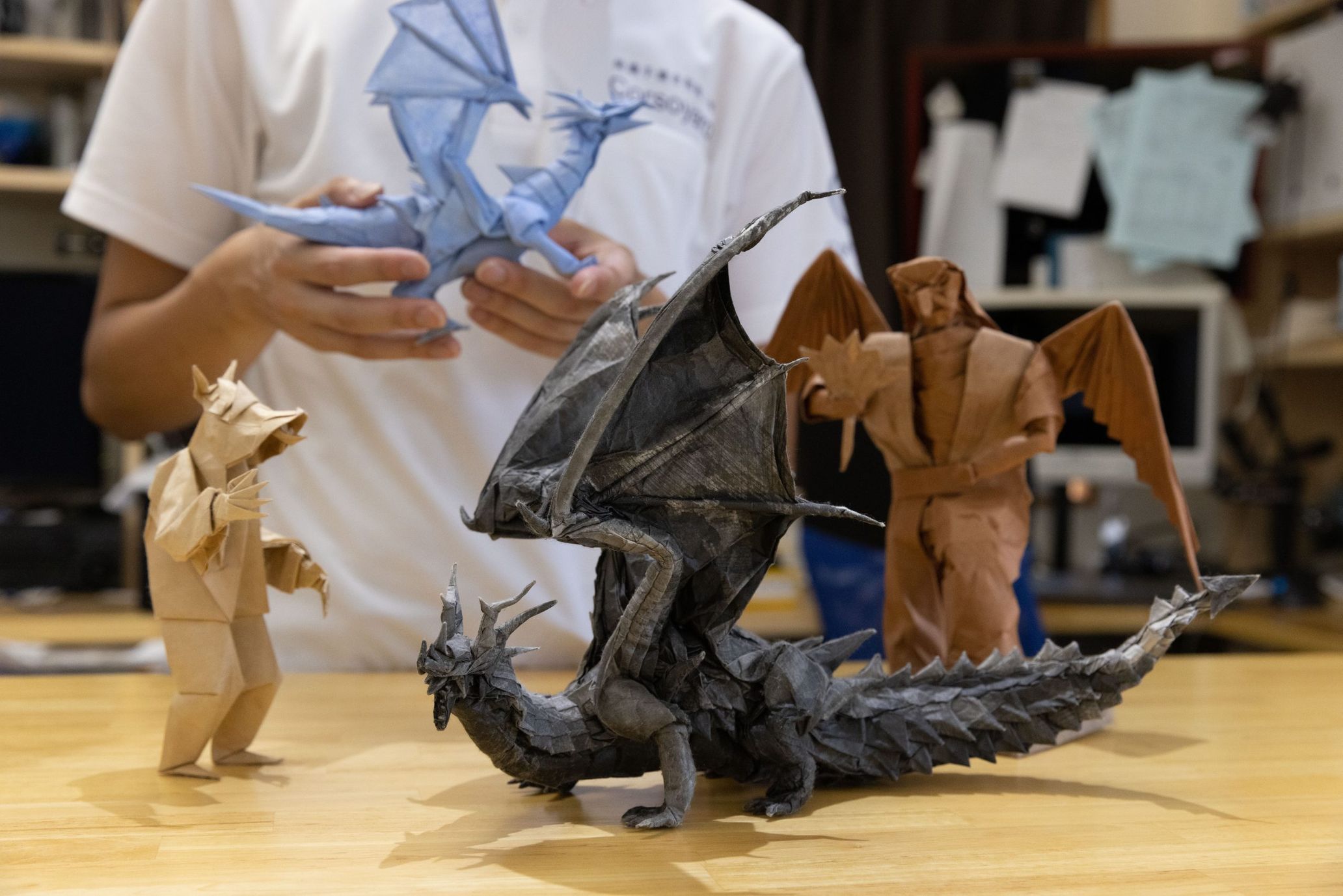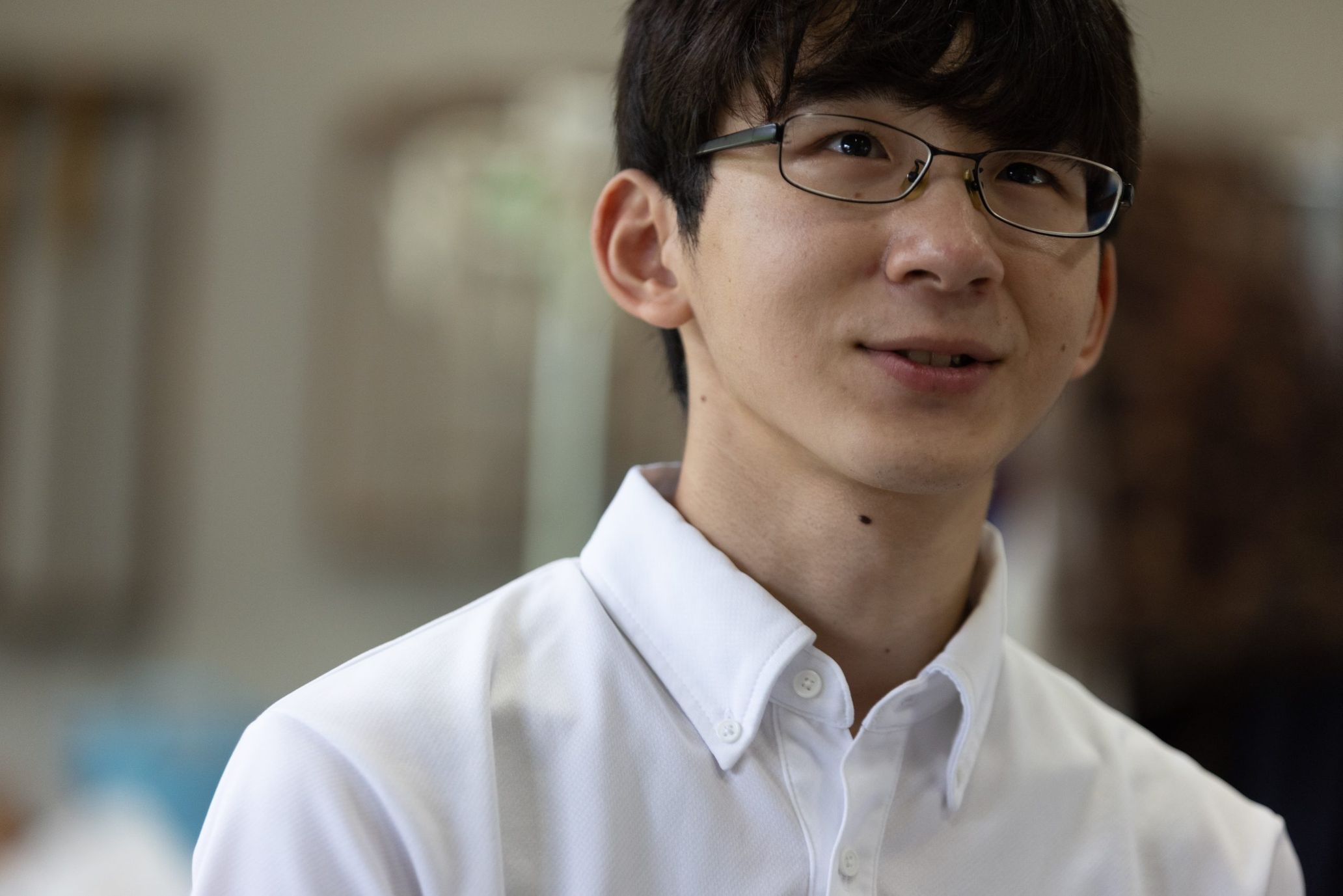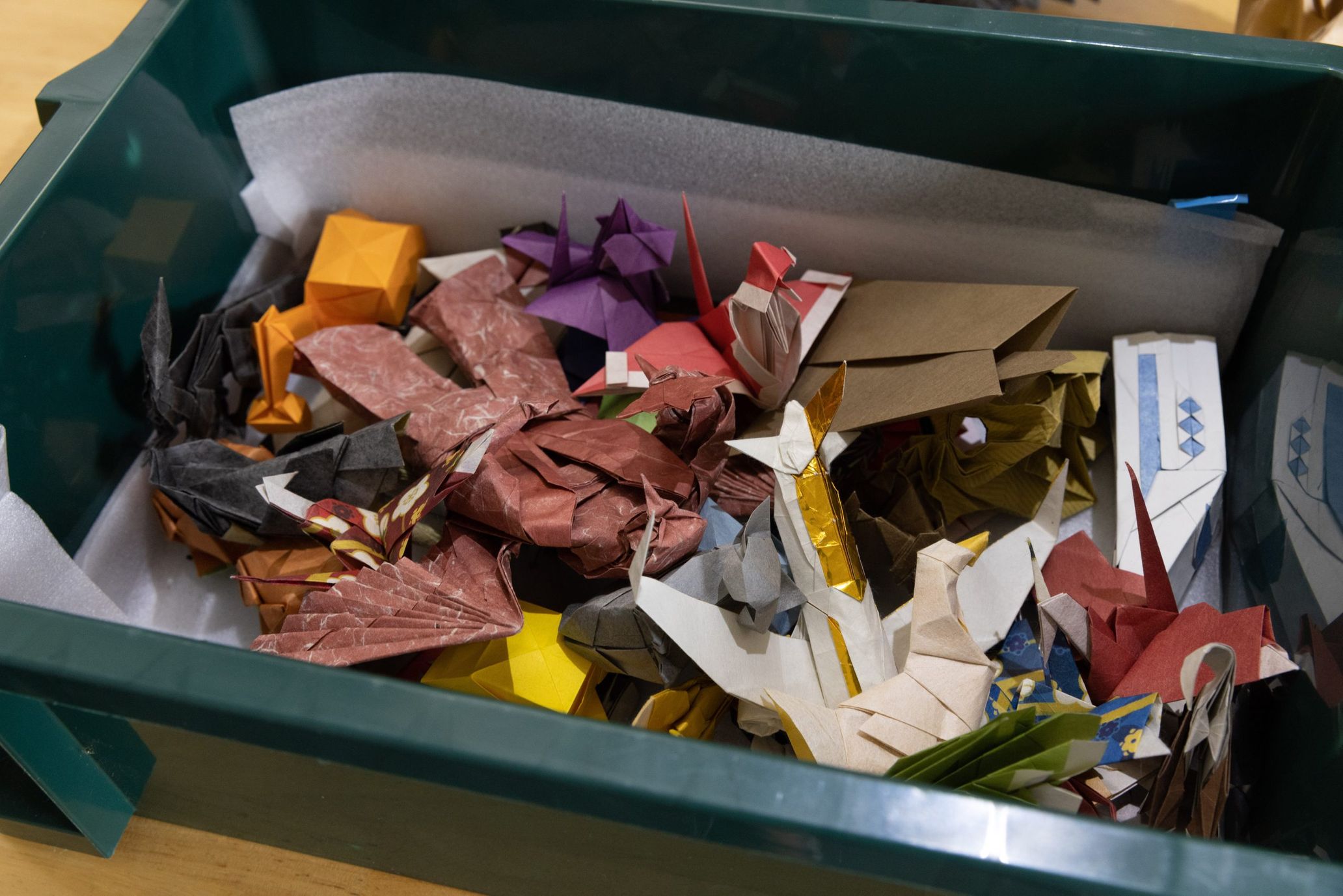Perhaps you’ve noticed that the origami landscape has changed dramatically over the past few decades. Most people probably associate origami with children’s games, or with wish-making and traditional culture, as symbolized by the one thousand folded paper cranes. A new type of origami, called super complex origami, which is distinct from such traditional origami, is gaining popularity around the world. The aim of this trend is to create “super complex” three-dimensional forms using only a single sheet square paper, without the use of cutting or pasting. Some larger works require about 400 folding steps, although it’s interesting to see how the finished works vary considerably depending on the skill and style of the folders and the paper they use. On social media, origamists (origami artists and enthusiasts) are posting their works and other creators’ names in hashtags to connect with each other, and have successfully formed a unique community without age or borders.
Super complex had its first boom in the 2000s. “TV Champion National Origami King Competition” (1999~) first triggered its popularity. The year 2008, when Origami champion Satoshi Kamiya appeared for his fifth consecutive championship, can be said to be the peak of this boom. That same year, University of Tokyo’s Origami Circle, Orist, was also founded, and in the 2010s, when the theoretical school of origami took over, the next generation of kids to carry the future of origami were steadily growing up all over Japan. We interviewed one of those children, Yuga Arisawa. He has been involved in the art of complex origami since his junior high school days. In the process, he became fascinated with the appeal of paper itself, and apprenticed at a handmade washi workshop upon graduating high school. He is possibly the only origami artist in Japan who starts his craft from paper making (he also grows his own plants, used as the raw material for his paper).
While the TV Champion team of the 2000s were revered as origami kings, Yuga Arisawa is commonly known and loved as origami prince (named after his appearance on “Matsuko no Shiranai Sekai.”) In recent years, he has received a slew of offers from companies to collaborate, and is increasing his presence in origami beyond genres, such as designing 3D gacha (Bandai), official mascots and logos (Rolls-Royce, Mount Rainier), and pleated skirts (United Arrows). He is now 24 years old. In Part I, we speak with him about the appeal and possibilities of contemporary origami as we take a closer look at his hybrid works.

First encounter with Origami
–– When did you first start origami?
Yuga Arisawa: When I was in kindergarten. Same time as everyone else. At the time, origami was all in books available at bookstores and libraries, so I thought there was nothing I couldn’t fold. That confidence quickly shattered when I watched “TV Champion National Origami Championship” when I was in the third grade. I was shocked to see how complex origami could be, and became more and more fascinated with it.
–– What were you folding when you were in elementary school?
Arisawa: When I was in fifth grade, I learned that there was a collection of works by Satoshi Kamiya, the “TV Champion” winner, and begged my parents to order it online through the publisher, Origami House. From there, I got hooked on the complex art of origami and began to create my own original works in middle school.
–– Mr. Satoshi Kamiya is the leading expert on super complex origami, isn’t he?
Arisawa: That’s right. At that time, I don’t think there was any other artist who could manipulate complexity on the level of Mr. Kamiya.His pace of creation was also very fast, so there were new works coming out constantly. That alone gave me goosebumps, but when I actually folded complex origami, the beauty of the structure was more shocking than anything.

©arisawayuga
–– “Ancient Dragon,” which is the cover of his first collection of works, and “Ryujin” are considered some of Mr. Kamiya’s representative works. And for you, “Azul Dragon” and “IBUKI” (pictured above). Are dragons a theme that many origami artists want to challenge themselves with?
Arisawa: Each origami artist certainly has his or her own dragon. One reason may be that dragons are easy to recognize at a glance. In the generation before mine, origami clubs at famous universities like Tokyo University, Waseda University, and Kyoto University became popular. At that time, origami theory evolved considerably, and works incorporating revolutionary structures emerged. However, it was difficult for the general public to understand the significance of these works. I’ve also continued my research on structure, but when I show my best works to my friends and family, their reactions are not so good at times. On the other hand, dragons have a complex structure but still look good and are easy to understand.
–– Your style includes many unique characters. Your works like “Christmas Tsurue” (Christmas tree x crane), “Kadomatsuru” (Kadomatsu x crane), and “Witch Tsuru,” which are all variations of the origami crane that everyone knows, are very popular.
Arisawa: That’s right. There’s also ”horse person” (*the body is a human and the face is a horse), which was a common character during my blogging days. The response was so overwhelmingly positive that it became a series. I sometimes let the character carry instruments like clarinets and trombones. I like that the works themselves look fun.

From traditional origami to modern origami
–– The original form of origami is simple, easy to understand, and enjoyable for everyone. The genealogy of origami can be traced back to an artist named Akira Yoshizawa (1911-2005). He was born in the Meiji era (1868-1912), and I believe he was a pioneer who led origami, which until then had a flat and straight structure, into the creative world of three-dimensional & curved paper. His structures were still simple and organic, though.
Arisawa: Mr. Yoshizawa is considered the father of modern origami. I’m also interested in older styles of origami, and once went to see an exhibition of Mr. Yoshizawa’s works held after his death. He was the first person to bring the concept of creation to origami. I believe the popularity of origami overseas can be traced back to his influence, as well. Considering the historical background of the time when only fixed folding methods existed, the quality of his work is truly amazing.
–– After a little research, I found out that for half a century from the 1950s into his later years, Mr. Yoshizawa traveled to 54 countries around the world under the dispatch of the Ministry of Foreign Affairs and the Japan Foundation to promote Japanese art to the world.
Arisawa: That was quite recent, wasn’t it? The generation that grew up watching Mr. Yoshizawa’s origami nurtured the next generation, and then the next… this has been a trend in contemporary origami for the past several decades. In the midst of this trend, there are also artists who sometimes bring about new changes.
–– Any examples?
Arisawa: Jun Maekawa began “designing” origami with a structure called the angle system, which can be used to theoretically design origami by constructing a consistent diagram using only nuclei that are multiples of 22.5 degrees, which is four equal parts of 90 degrees. Until then, most origami was folded in the gurai-ori style, in which the paper is folded at a rough estimate, until the artist is satisfied. After the advent of Mr. Maekawa, origami became something to be designed. Most of today’s origami is based on Maekawa’s foundation.
Then there’s also Satoshi Kamiya. Like me, there are still many kids who got into origami because of Mr. Kamiya’s influence, and we are now at a point where “Ancient Dragon” is being folded in the first grade. It was unthinkable just ten years ago. I’m so envious of this new generation.

Into the realm of more than just making shapes
–– How do you see the potential of origami? First off, can you make a living from origami?
Arisawa: Although one can make money through book publishing and workshops, I don’t think there are any artists in Japan who are making a living purely from their creations. Origami has become an art form in other countries, though, so it’s more of a viable business there.
–– Origami is also more talked about in the context of art overseas, and seems to possess a wider range of expression there.
Arisawa: I think that’s true. A piece of paper folded in a corner can be considered origami in other countries. In the origami we’re exploring, there’s first a desired form, and then it’s all about how to fold it out. That process is fun. That’s why I’m not so attached to the finished product as an origami artist.

–– How do you store the large number of works you have created so far?
Arisawa: I’ve been packing them into containers and cardboard boxes. Paper tends to fall apart easily, so by storing all of my works in one box, each piece supports each other and acts as buffers. I never display them in my room so that they maintain their condition.
–– So contemporary origami is more a world of design than of craftsmanship?
Arisawa: Origami as a job is mostly about design. For example, a request I received from Rolls-Royce in the fall of 2019 was to design the Spirit of Ecstasy (Rolls-Royce’s iconic bonnet ornament) origami and do a performance during the exhibition. I also drew the origami diagrams to be handed out to exhibition visitors, created the graphics for the posters, printed them on my own handmade paper, and delivered them myself.

–– One of the characteristics of origami artists is that when they create something, they show all the details of their work to the public. The work is done right up to the point of folding it into a diagram.
Arisawa: It’s the same with publishing a book. A book published by an origami artist takes an enormous amount of time because it involves more than 1,500 steps in total to create a picture. Origamists can make origami without a fold diagram, just by using a diagram with only fold lines. Advanced users can usually fold it just by looking at the finished product.
–– Like playing music by ear?
Arisawa: Exactly. Origami artists call this the nirami fold (stare fold), where you stare at the finished product and fold it while anticipating the folding pattern.
–– I didn’t know that was possible… In the world of origami where there are many skilled artists, you’re unique in that you are also a craftsman and make your own paper.
Arisawa: Ever since I was a child when I started creating, I was more interested in paper itself than creating interesting shapes. Paper created by human hands has an energy to it, and I merely transform it in the direction that makes the most of that energy. That’s how I always feel when creating origami. I wanted to try handmade washi because I sought to find the ideal paper for origami, but above all because I wanted to create something from scratch. I wanted to figure out how to not only transform a piece of paper, but how to create the paper itself. I thought I could do something unique by starting from the paper-making process. (Continued in Part 2)

Yuga Arisawa
Born in Sapporo, Hokkaido in 1997. He first encountered origami in kindergarten and began tackling complex origami at the age of twelve, when he started working creatively. After graduating from high school in 2016, he became an apprentice at Corsoyard, a Mino handmade washi studio, where he now develops and designs products utilizing both origami and handmade washi. He is the author of Origami Oji no Kawaii! Keredo Muzukashisugiru Origami (2019/KADOKAWA) and Origami Oji no Sugo Waza! Origami (2020/Kawade Shobo Shinsha), and Origami Oji no Sugo Waza! Origami Japonism (scheduled for release in October 2022/Kawade Shobo Shinsha). His nickname “Prince of Origami” took root after his appearance on “Matsuko no Shiranai Sekai.” He has collaborated with Bandai, Meiji, Rolls-Royce, United Arrows, and many other companies.
Translation Mimiko Goldstein
